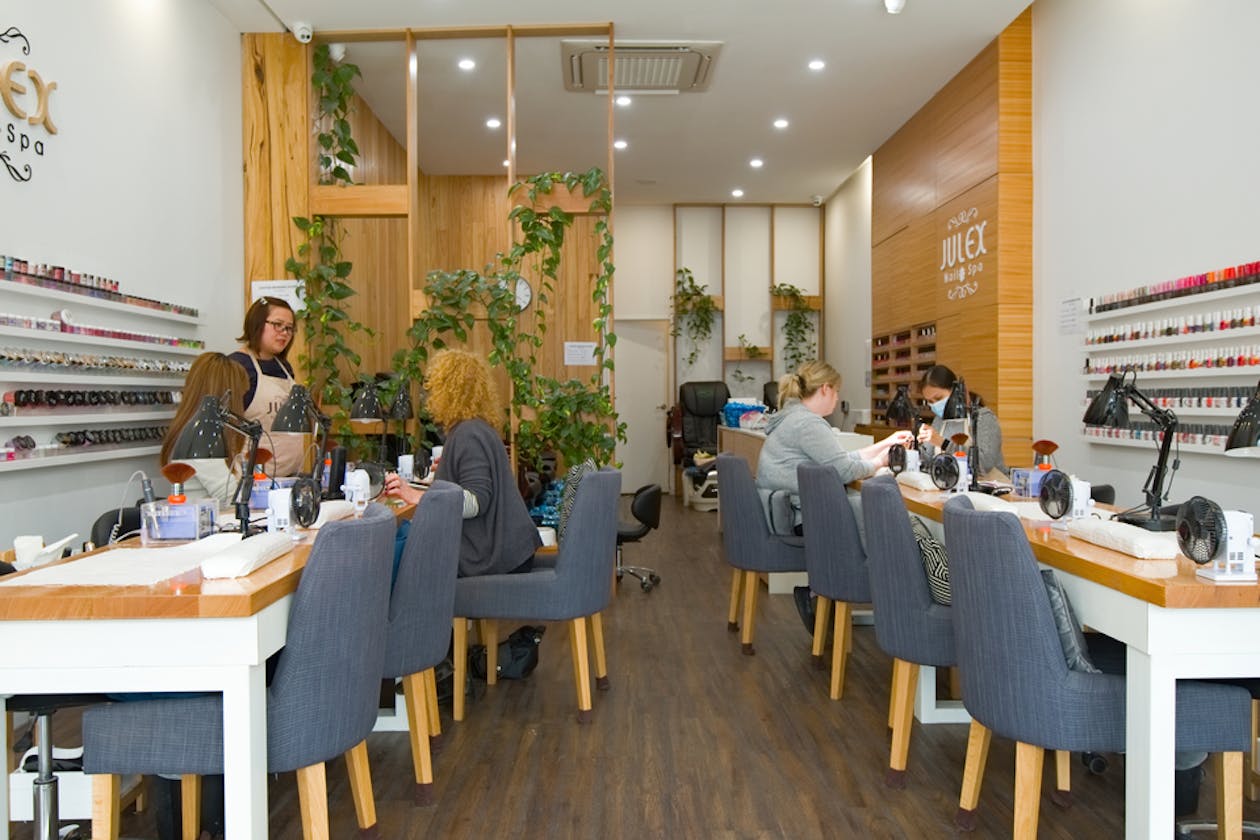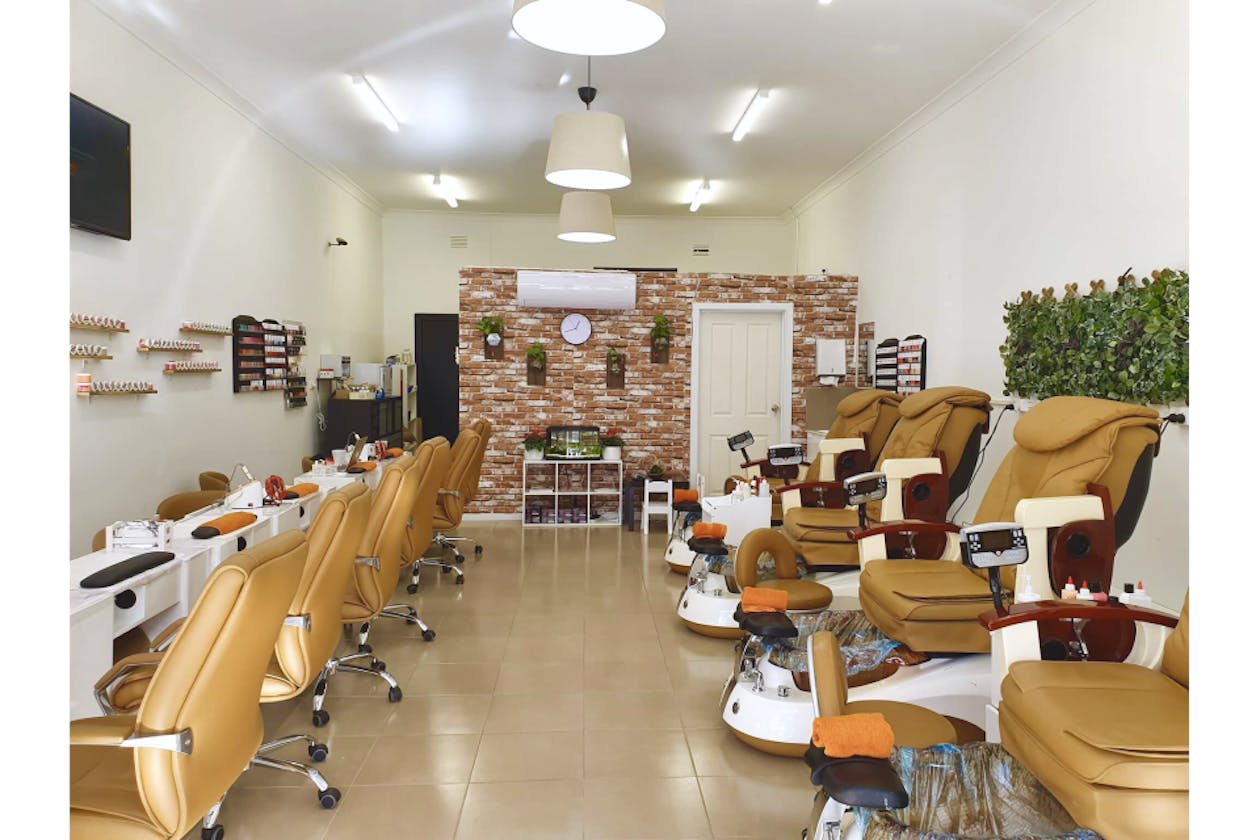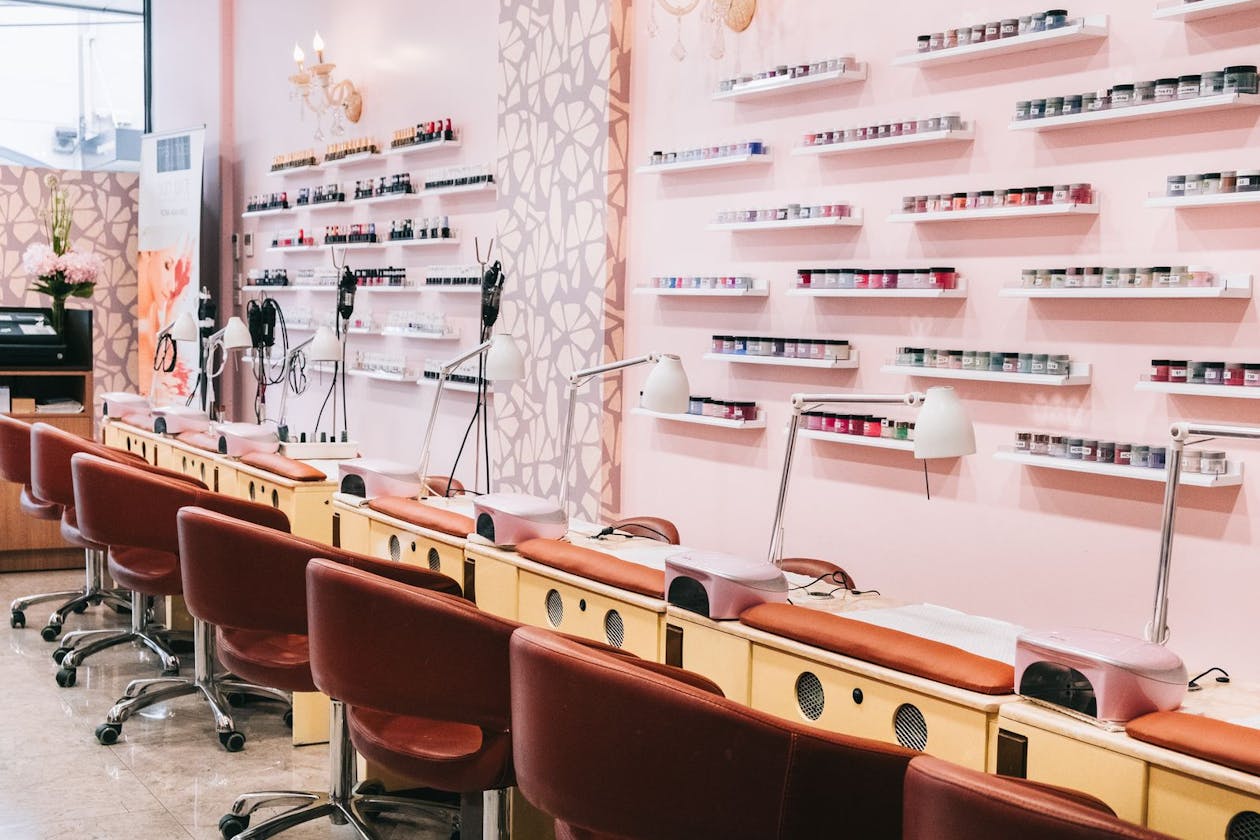
Gel Nails Book your gel nails appointment online and save
Top 20 Gel Nail SalonsFor more salons, check out Fresha’s list of Nail Salons.
 422 Bourke Street, Melbourne CBD 3000(119)Are your hands or feet in need of TLC, head straight over to Absolutely Polished, Melbourne CBD. This award-winning nail salon has everything you need.
422 Bourke Street, Melbourne CBD 3000(119)Are your hands or feet in need of TLC, head straight over to Absolutely Polished, Melbourne CBD. This award-winning nail salon has everything you need.
Seven Salon
157B/157b East Boundary Road, Bentleigh East 3165(14)For all your nail, lash and brow needs in Bentleigh East, Seven Salon on East Boundary Road is your go-to destination. Book an appointment online today.
The Queen Total Beauty
8 Woodland Street, Melbourne (Strathmore), Victoria, Strathmore 3041(193)Experience the ultimate relaxation with The Queen Beauty and Massage. Services include massage, eyelash extensions and facials to cater to all skin concerns.
Julex Nail Spa - Prahran
514 Malvern Road, Prahran 3181(37)For the smartest nails in Prahran, book in for a mani or a pedi at Julex Nail Spa. Get perfect nails with polish, Shellac gel, acrylics or an SNS dip powder.
The Nail Hair and Beauty Room Mornington
Shop 6 / 211 Main Street, Mornington 3931(94)Overhaul your look with The Nail, Hair and Beauty Room. Choose from nail treatments, waxing, hair colouring, and more.
Heidi's Beauty Effects
Shop 12, 3 / 15 Dennis Rd, Springwood 4127(5)Heidi's Beauty Effects is a boutique beauty salon in Springwood. Guided by Heidi's 25 years of experience, this salon offers high-quality beauty therapy and treatments.
Dermal Boutique - Kogarah
2 / 55 President Avenue, Kogarah 2217(64)Dermal Boutique is a Kogarah-based beauty and hair removal provider specialising in unisex waxing and skin treatments. Live your life hair-free and glowing thanks to their services.
Your Time Beauty
163 Pascoe Vale Road, Moonee Ponds 3039(47)Your Time Beauty in Moonee Ponds is your go-to when you need some ‘me time’ in the form of massage, waxing, facials, lash and brow maintenance and spa packages.
Mollyfuns Nail Art
Level 1, 241- 245 Lonsdale street, Melbourne CBD 3000(36)Mollyfuns Nail Art will customise each manicure and pedicure to the guests' unique needs. The experts offer impressive nail art design, and lash extensions.
Accent Nail Bar
11-19 Bank Place , Melbourne CBD 3000For all your pampering needs, from skin and nails to facials and massage, indulge in a well-deserved appointment at Accent Nail Bar on Bank Place in Melbourne.
I Love Nails
52 Glen Eira Road, Ripponlea 3185(43)I Love Nails is a boutique nail salon located in Ripponlea offering locals premium manicures and pedicures in a professional salon environment.
Modern Nails Brunswick
134 Sydney Road, Brunswick 3056(89)Feel amazing from top to toe with Modern Nails Brunswick. From acrylic colour, to Bio Sculpture gel, waxing and eyelash extensions, they're experts in beauty.
Diva Care
164 Bridge Road, Richmond 3121(13)Diva Care really knows their stuff when it comes to manicures and pedicures. Pop into the gorgeous salon for a spa treatment or wax, too.
Salon Oasis
11/363 Hillsborough Road , Warners Bay 2282(1119)Relax, indulge and rejuvenate with Salon Oasis in Warners Bay. Choose from an array of pampering treatments including full body massage, deluxe mani or facial.
Coco Nails
Shop 2 / 53-61 Toorak Road, South Yarra 3141(116)Transform your nails from boring to breath taking with Coco Nails! You'll find all your favourites including SNS, acrylic, gel, and eyelash extensions, too.
Island Sea Nails & Beauty
5 / 150 Liverpool Street, Darlinghurst 2010(96)Island Sea Nails & Beauty invites you to experience the friendly and warm atmosphere, the staff here aim to make you feel completely pampered and polished.
Sunny Rose Nails & Beauty
175 Smith Street, Fitzroy 3065(30)
Greville Nails
124 Greville Street, Prahran 3181(66)Greville Nails is a boutique nail salon located in Prahran. The expert team are consummate professionals, consistently delivering high-quality manicures and pedicures.
Glitzy Glam Beauty Salon
Shop 3 970 Logan Rd, Holland Park West 4121(27)Glitzy Glam Beauty Salon is dedicated to your beauty. Her one-stop shop for all beauty needs, offering threading, waxing, facials and nail treatments.
Chapel's Beauty Salon
81A Chapel Street, Windsor 3181(170)Visit Chapel's Beauty Salon, and be pampered to perfection with an exceptional range of services to highlight your natural beauty and boost your confidence.
Gel Nails
There are so many fabulous nail treatments to choose from these days, it can get a little confusing. Acrylics, Gel Nails, Shellac - what's the difference? Let's find out.
Both acrylic and Gel Nails are basically fake nails placed on top of your own. They can be used to extend the nail and give it extra strength. But they are very different in terms of application and use.
Shellac is neither acrylic nor gel. It is actually a blend of gel and nail polish. It can't be used to extend your nail, but it does give you excellent durability.
Teething Problems
Gel nails probably first appeared in the United States in the 1980s. At that time, however, the idea didn't really catch on. This was largely due to problems with the lights used to set the gel.
There was little training available and, if done incorrectly, the process could leave both client and nail technician with burnt fingertips. Making matters worse, home-use systems were also introduced, which did nothing to improve the product's reputation.
One decade and a whole lot of research later, gel nails were back. By 2010, well over half of salons offered this as a service and today, well, it's available everywhere.
What is Gel?
These days, however, gel nails come in many forms, including 3-D gels, polish-gel hybrids, soak-off gels and more. In its most basic form, gel is a semi-solid mix of monomers and oligomers that harden to a polymer when exposed to UVA light.
The gel contains photoinitiators - to absorb the light, stabilisers - to prevent discolouration and pigments - to give it colour. Interestingly, it's the pigments that required the most research. Some colours, like white, reflect the UVA light while others, like black, absorb it. This means the nail technician must set the light correctly for best results.
Advantages of Gel Nails
Gel Nails offer many advantages over some other nail treatments. They set faster, last longer and are easier to remove. They give a glossy but natural look, and they are more flexible than acrylic nails.
Hybrid brush-on gel polishes are the latest innovation, combining the best of all worlds. They go on as easily as nail polish and soak off faster than traditional gels. They also give you the durability of gel nails.
The main difference between nail polish and gel nails is that durability. Nail polish contains mostly nitrocellulose resin, which will scratch off. Gel nails use urethanes, which offer excellent scratch resistance.
Weighing It Up
Gel nails are applied in much the same way as nail polish, with a base coat, colour and then top coat. Each coat has to be cured under the UVA light. Properly applied, gel nails are as strong as acrylic but not as thick, so they look more natural.
Cost-wise, gel nails work out about the same as acrylics but bear in mind that you can keep acrylics going with cheaper monthly infills. Soak-off gels last up to 14 days.
When you're choosing a nail treatment, consider your lifestyle. If your nails are in and out of water all day, the gel would be the better option. Because it sticks like a nail polish it's better at resisting water. Acrylics can start lifting if subjected to too much water.
Are Gel Nails Safe?
You may be wondering if the use of UVA light to cure your gel nails is dangerous. Certainly, there have been many debates on the subject. There is no evidence to suggest that having regular gel nail treatments will give you skin cancer. The US Skin Cancer Foundation looked into this and said the risk was far lower than that presented by tanning devices.
If you are concerned, however, you could apply sunscreen to your hands before your nail treatment. Try and avoid applying it to the nails themselves.
Book Gel Nails in your city
- Adelaide
- Ararat
- Ballarat
- Bathurst
- Benalla
- Blue Mountains
- Brisbane
- Burnie
- Cairns
- Canberra
- Central Coast
- Cobram
- Coffs Harbour
- Colac
- Darwin
- Devonport
- Geelong
- Gippsland
- Gold Coast
- Hervey Bay
- Launceston
- Mackay
- Maitland
- Mansfield
- Melbourne
- Mildura
- Mornington Peninsula
- Newcastle
- Northern NSW
- Orange
- Perth
- Port Macquarie
- Regional NSW
- Regional NT
- Regional QLD
- Regional SA
- Regional Tasmania
- Sunshine Coast
- Sydney
- Toowoomba
- Torquay
- Townsville
- Wangaratta
- Warrnambool
- Warwick
- Wollongong